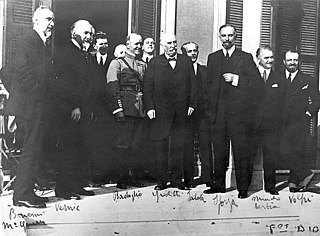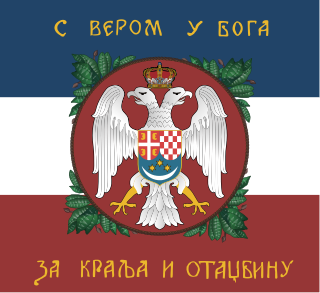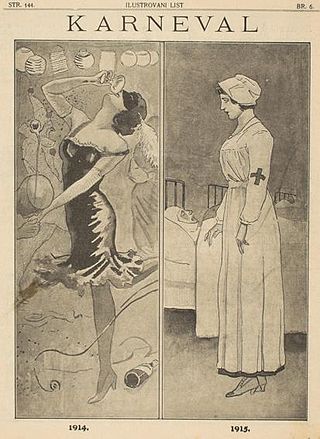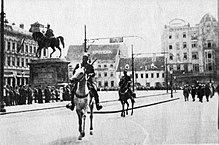
The Treaty of Rapallo was an agreement between the Kingdom of Italy and the Kingdom of Serbs, Croats and Slovenes in the aftermath of the First World War. It was intended to settle the Adriatic question, which referred to Italian claims over territories promised to the country in return for its entry into the war against Austria-Hungary, claims that were made on the basis of the 1915 Treaty of London. The wartime pact promised Italy large areas of the eastern Adriatic. The treaty, signed on 12 November 1920 in Rapallo, Italy, generally redeemed the promises of territorial gains in the former Austrian Littoral by awarding Italy territories generally corresponding to the peninsula of Istria and the former Princely County of Gorizia and Gradisca, with the addition of the Snežnik Plateau, in addition to what was promised by the London treaty. The articles regarding Dalmatia were largely ignored. Instead, in Dalmatia, Italy received the city of Zadar and several islands. Other provisions of the treaty contained safeguards for the rights of Italian nationals remaining in the Kingdom of Serbs, Croats and Slovenes, and provisions for commissions to demarcate the new border, and facilitate economic and educational cooperation. The treaty also established the Free State of Fiume, the city-state consisting of the former Austro-Hungarian Corpus separatum that consisted of Rijeka and a strip of coast giving the new state a land border with Italy at Istria.

The State of Slovenes, Croats and Serbs was a political entity that was constituted in October 1918, at the end of World War I, by Slovenes, Croats and Serbs (Prečani) residing in what were the southernmost parts of the Austro-Hungarian Empire. Although internationally unrecognised, this was the first incarnation of a Yugoslav state founded on the Pan-Slavic ideology. Thirty-three days after it was proclaimed, the state joined the Kingdom of Serbia to form the Kingdom of Serbs, Croats and Slovenes.

The Corfu Declaration was an agreement between the prime minister of Serbia, Nikola Pašić, and the president of the Yugoslav Committee, Ante Trumbić, concluded on the Greek island of Corfu on 20 July 1917. Its purpose was to establish the method of unifying a future common state of the South Slavs living in Serbia, Montenegro and Austria-Hungary after the First World War. Russia's decision to withdraw diplomatic support for Serbia following the February Revolution, as well as the Yugoslav Committee's sidelining by the trialist reform initiatives launched in Austria-Hungary, motivated both sides to attempt to reach an agreement.

The Yugoslav Committee was a World War I-era, unelected, ad-hoc committee that largely consisting of émigré Croat, Slovene, and Bosnian Serb politicians and political activists, whose aim was the detachment of Austro-Hungarian lands inhabited by South Slavs and unification of those lands with the Kingdom of Serbia. The group was formally established in 1915 and it last met in 1919, shortly after the breakup of Austria-Hungary and the establishment of the Kingdom of Serbs, Croats and Slovenes, which was later renamed Yugoslavia. The Yugoslav Committee was led by its president the Croat lawyer Ante Trumbić and, until 1916, by Croat politician Frano Supilo as its vice president.

The Yugoslav Army, commonly the Royal Yugoslav Army, was the principal ground force of the Kingdom of Yugoslavia. It existed from the establishment of Yugoslavia in December 1918 until its surrender to the Axis powers on 17 April 1941. Aside from fighting along the Austrian border in 1919 and 1920 related to territorial disputes, and some border skirmishes on its southern borders in the 1920s, the JV was not involved in fighting until April 1941 when it was quickly overcome by the German-led invasion of Yugoslavia.
Josip Metzger was a member of the fascist Ustaše movement who rose to the rank of major general in the Independent State of Croatia during World War II. He was tried, sentenced and executed for war crimes after the war.

Yugoslavism, Yugoslavdom, or Yugoslav nationalism is an ideology supporting the notion that the South Slavs, namely the Bosniaks, Croats, Macedonians, Montenegrins, Serbs and Slovenes, but also Bulgarians, belong to a single Yugoslav nation separated by diverging historical circumstances, forms of speech, and religious divides. During the interwar period, Yugoslavism became predominant in, and then the official ideology of the Kingdom of Yugoslavia. There were two major forms of Yugoslavism in the period: the regime favoured integral Yugoslavism promoting unitarism, centralisation, and unification of the country's ethnic groups into a single Yugoslav nation, by coercion if necessary. The approach was also applied to languages spoken in the Kingdom. The main alternative was federalist Yugoslavism which advocated the autonomy of the historical lands in the form of a federation and gradual unification without outside pressure. Both agreed on the concept of National Oneness developed as an expression of the strategic alliance of South Slavs in Austria-Hungary in the early 20th century. The concept was meant as a notion that the South Slavs belong to a single "race", were of "one blood", and had shared language. It was considered neutral regarding the choice of centralism or federalism.
The Green Cadres, or sometimes referred to as; Green Brigades or Green Guards, were originally groups of Austro-Hungarian Army deserters in the First World War. They were later joined by peasants discontented with wartime requisitioning, taxation, and poverty. A substantial number of desertions to the Green Cadres occurred as early as 1914, with their numbers peaking in the summer of 1918. They were present in nearly all areas of Austria-Hungary, but particularly large numbers were found in Croatia-Slavonia, Bosnia, Western Slovakia and Moravia, as well as in Galicia. The Green Cadres had no centralised structure and relied on peasants and banditry for food and shelter. As Austria-Hungary fell apart in October 1918, violent outbreaks associated with the Green Cadres peaked. These occurrences were particularly severe in Croatia-Slavonia, Slovakia and Galicia. "Greens" were also present in large areas of the Russian Empire, particularly in present-day Ukraine, however, this page is only about the Green Cadre in the former Austro-Hungarian Monarchy.

The May Declaration was a manifesto of political demands for unification of South Slav-inhabited territories within Austria-Hungary put forward to the Imperial Council in Vienna on 30 May 1917. It was authored by Anton Korošec, the leader of the Slovene People's Party. The document was signed by Korošec and thirty-two other council delegates representing South-Slavic lands within the Cisleithanian part of the dual monarchy – the Slovene Lands, the Dalmatia, Istria, and the Condominium of Bosnia and Herzegovina. The delegates who signed the declaration were known as the Yugoslav Club.
The National Council of Slovenes, Croats and Serbs claimed to represent South Slavs living in Austria-Hungary and, after its dissolution, in the short-lived State of Slovenes, Croats and Serbs. The council's membership was largely drawn from various representative bodies operating in the Habsburg crown lands inhabited by South Slavs. The founding of the National Council in Zagreb on 8 October 1918 fulfilled the Zagreb Resolution to concentrate South Slavic political forces, adopted earlier that year on the initiative of the Yugoslav Club. The council elected Anton Korošec as the president and Svetozar Pribićević and Ante Pavelić as vice-presidents.

The Triune Kingdom of Croatia, Slavonia and Dalmatia was part of Austria-Hungary during World War I. Its territory was administratively divided between the Austrian and Hungarian parts of the empire; Međimurje and Baranja were in the Hungarian part (Transleithania), the Kingdom of Croatia-Slavonia was a separate entity associated with the Hungarian Kingdom, Dalmatia and Istria were in the Austrian part (Cisleithania), while the town of Rijeka had semi-autonomous status.

The Lipošćak affair was an alleged conspiracy led by the former Austro-Hungarian Army General of the Infantry Anton Lipošćak to seize power in the recently proclaimed State of Slovenes, Croats and Serbs at the end of the First World War. The majority view of the allegations is that they were fabricated by allies of the Croat-Serb Coalition leader Svetozar Pribičević. Lipošćak was arrested on 22 November 1918 under suspicion of treason. He was accused of plotting to establish councils composed of workers, peasants and soldiers in place of the existing authorities with the aim of reviving the Habsburg monarchy, or working on behalf of foreign powers or the Bolsheviks.

The Geneva Declaration, Geneva Agreement, or Geneva Pact was a statement of political agreement on the provisional political system in the future union of the South Slavs living in the territories of the former Austro-Hungarian Empire and Kingdom of Serbia. It was agreed by Serbian Prime Minister Nikola Pašić on behalf of Serbia, representatives of Serbian parliamentary opposition, representatives of the National Council of the State of Slovenes, Croats and Serbs which recently seceded from Austria-Hungary, and representatives of the Yugoslav Committee. The talks held in Geneva, Switzerland on 6–9 November 1918 built upon and were intended to supersede the 1917 Corfu Declaration agreed by Pašić and Yugoslav Committee president Ante Trumbić. The basis for the talks was provided by the Greek Prime Minister Eleftherios Venizelos on behalf of the Supreme War Council of the Triple Entente. The talks were necessary in the process of creation of Yugoslavia as a means to demonstrate to the Entente powers that various governments and interests groups could cooperate on the project to establish a viable state.
The Zagreb Resolution was a political declaration on the need for political unification of the Croats, the Slovenes and the Serbs living in Austria-Hungary. It was adopted by representatives of opposition political parties in the Kingdom of Croatia-Slavonia presided by Ante Pavelić in a meeting held in Zagreb on 2–3 March 1918. The declaration relied on the right of self-determination and called for establishment of an independent democratic state respecting rights of individuals and historically established polities joining the political union. It also called for ensuring cultural and religious equality in such a union. The Zagreb Resolution established a preparatory committee tasked with establishment of the National Council of Slovenes, Croats and Serbs intended to implement the resolution. The National Council was established on 5 October in proceedings described by Pavelić as a continuation of the Zagreb conference that March.
Lav Mazzura was a politician and lawyer born in Zagreb. After studying law in Zagreb and Prague, he became one of leaders of the Croatian Progressive Youth. He was the editor of the Hrvatski pokret and the Hrvatska misao journals. In 1910–1913, Mazzura was a member of the Sabor of the Kingdom of Croatia-Slavonia as a member of the Croat-Serb Coalition led by Frano Supilo and Svetozar Pribičević. He was also a member of the joint Hungarian-Croatian Parliament in Budapest. In November–December 1918, Mazzura was in command of Zagreb-based forces assigned to the Commission for Public Order and Security of the National Council of Slovenes, Croats and Serbs – a body composed of political representatives of the South Slavs living in Austria-Hungary tasked with achieving independence of South Slavic lands from the empire. According to testimony of Slavko Kvaternik, Mazzura was involved in unsuccessful negotiations to peacefully resolve a standoff during the 1918 protest in Zagreb. In 1919, Mazzura was appointed to the post of the prosecutor for the city of Zagreb. He died in Zagreb in 1930.

In the immediate aftermath of World War I, the region of Međimurje was occupied by forces loyal to the National Council of the State of Slovenes, Croats and Serbs, one of the predecessor states to the Kingdom of Yugoslavia, in November and December 1918. Predominantly inhabited by Croats, this territory was a part of the Kingdom of Hungary until it was captured by Yugoslav forces. The region was annexed by Yugoslavia, which was awarded it at the Paris Peace Conference (1919–1920).

Ivo Frank was a Croatian politician and lawyer, and member of the Party of Rights. Frank gained prominence as a member of the group that tore down a Hungarian flag to protest the 1895 visit by Emperor Franz Joseph to Zagreb. He was elected a member of the Kingdom of Croatia-Slavonia's parliament in the final decade of the Austro-Hungarian Empire. Before the dissolution of Austria-Hungary, Frank advocated for trialist reform of the empire as a means of protection against the Magyarisation and Serbian irredentism. Following the establishment of the Kingdom of Serbs, Croats and Slovenes in 1918, Frank left the country to lead the émigré Croatian Committee, which advocated for Croatian independence.

Frankists were followers of a political ideology that bases positions and lines around the thought of Josip Frank, a Croatian nationalist leader at the end of the 19th century who broke away from the Party of Rights to create his own movement.

Nikola Stojanović was a lawyer and Bosnian Serb and Yugoslavian politician. As a student, he wrote the article Serbs and Croats, printed in the Serbian Literary Herald, applying Social Darwinism and claiming that Serbs as 'superior people' would eventually assimilate the Croats. In the text, Stojanović announced war to extermination of either Serbs or Croats and the text has been cited as the blueprint for ethnic cleansing by Croatian writers. Following a politically-motivated reprint of the article in Srbobran, the newspaper of the Serb Independent Party in Zagreb, it led to 1902 riots targeting Serb businesses and homes in the city, involving a crowd of about 20,000.

Ivan Paleček was a Croatian and Yugoslavian politician and lawyer.



















